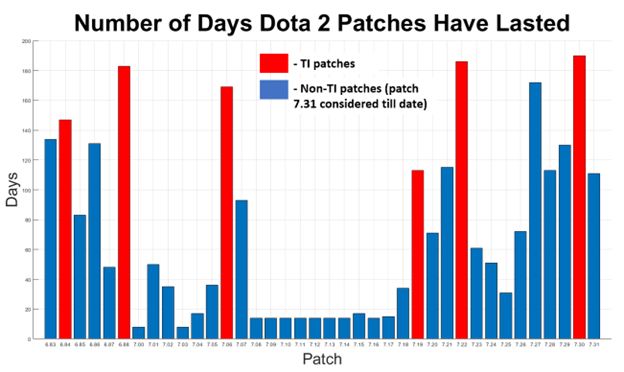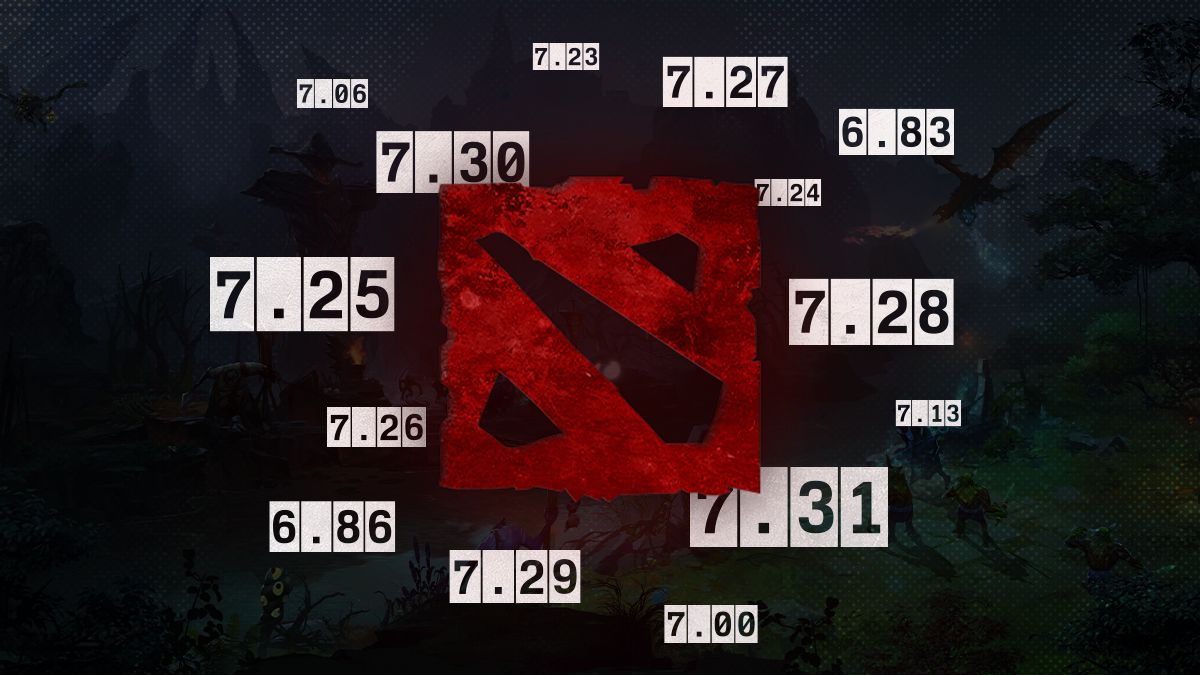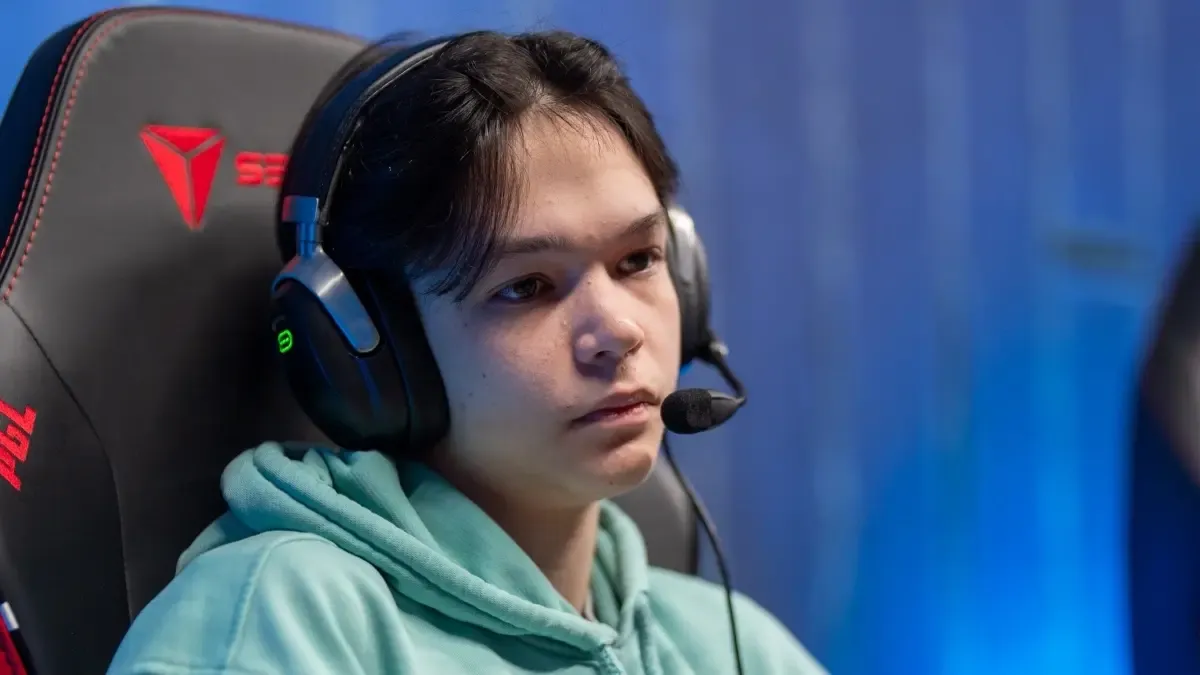It feels like an eternity playing on this patch, but is it? We take a look at the duration of various Dota 2 patches starting from the TI5 era to find out.
While the concept of Dota 2 is amazing and the plethora of heroes offer a near infinite permutations of how a game will play out, the thing that keeps the game fresh is patches. New patches and the metas that evolve around them lead to the development of strategies not seen before, even with the same bunch of heroes. Patches possibly play the most important role in keeping a major chunk of the Dota 2 community enthralled in the game.
Seeing as how important patches are for Dota 2, it would be interesting to see the trend in patch durations over the course of the previous Dota 2 seasons, especially now, given how the stale the state of the game has become . We start from Dota 2 patch 6.83, which was the patch before the TI5 patch, and come all the way up to Dota 2 patch 7.31, which is the current patch. The duration of all patches between 6.83 and 7.31 have been shown below, with TI patches uniquely depicted.

It is a pretty straightforward observation that the longest patches are TI patches, and that makes complete sense. With The International breaking esports records every year with insanely high prize pools, you want to give the teams trying to claim the Aegis a stable meta to prepare for the biggest Dota 2 even of the year. Typically, the TI patch has been released around three to four months before the tournament, and tends to carry on a couple of months after it, giving it a good five months (around 150 days). Typically, the TI patch has a few prominent tournaments played on it before The International championships, and based on what is observed in those tournaments, balance patches are released leading up to The International.
The small bunch of 14 day patches from patch 7.08 to patch 7.17 were part of an experiment where a new patch was released every two weeks, on a Thursday.
The experiment started off well, but then the patches started to feel a bit too quick and some were even dropped in between tournaments to adhere to the schedule, which led to IceFrog and Valve receiving a lot of backlash. Not too long after that, the two week system was scrapped.
But ever since then, the pendulum didn’t just come back to the center, it seems to have gone to the other extreme! In the last couple of years, patch durations have been increasing and that is evident especially of the post TI patches are observed.

The post TI patches usually take time to arrive as the Dota 2 team takes a well deserved break after The International, but in the past years, they have been massive breaths of fresh air for the game and don’t usually last too long. Let’s take a look at the last four post TI patches before Dota 2 patch 7.31, and see what the meta defining changes they brought with them.
Patch 7.00 – Patch 7.00 was a massive change in the world of Dota 2! The game was completely revolutionized with the advent of Dota 2 7.00, with talents, Shrines and the new hero Monkey King being introduced to the game.
Patch 7.07 – Patch 7.07 got rid of the extra creep in the mid lane, reducing the importance the mid lane had gotten during The International 2017 (TI7). There were map changes, prominent experience and gold changes and Dark Willow and Pangolier were added to the game.
Patch 7.20 – Patch 7.20 brough with it map changes, a change in the deny mechanics, XP changes. Root mechanics as well as cleave and splash mechanics were experimented with.
Patch 7.23 – Patch 7.23 brought Outposts to the game, along with neutral items. This patch removed a lot of hostility from pubs by giving every player their own courier, instead of one courier shared by the team. The ability to level up to 30 was also introduced with this patch. This was also the patch which saw Snapfire and Void Spirit join the fray.
So from TI6 to TI9, the patches following The International had some massive impacts on the game. A shaken up meta was presented, which would be refined and balanced till the last patch of the Dota 2 season.
But all that is in the rearview mirror. The situation at hand is much different. The last prominent change that the game saw which send a shiver of excitement through everyone’s spines was the introduction of the Aghanim’s Shard in Dota 2 patch 7.28. Ever since then, there hasn’t been a shock and awe change in the game. Patch 7.29 did have a lot of interesting changes that shook up the meta, but that was over 14 months ago, in April 2021. Since then the game has been stale. Granted, patch 7.30 has been one of the most stable patches produced by IceFrog and Valve, but that still doesn’t change the fact that with every day, the excitement is dying from the game. Patch 7.30 was the longest patch Dota 2 has seen in the last seven years with over a 190 days in the belt, and yet when patch 7.31 arrived, there were no map changes, no gold and experience changes, nothing done to Roshan or to Outposts. Not just that, it is by far the longest pot TI patch since TI5, and there is no end in sight. It seems like magic is fading, and the only hope is, there is something ginormous in the planning to make up for the slump that has overtaken the great game of Dota 2.








